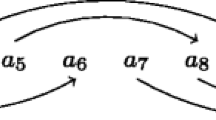Abstract
Most concurrent data structures being designed today are versions of known sequential data structures. However, in various cases it makes sense to relax the semantics of traditional concurrent data structures in order to get simpler and possibly more efficient and scalable implementations. For example, when solving the classical producer-consumer problem by implementing a concurrent queue, it might be enough to allow the dequeue operation (by a consumer) to return and remove one of the two oldest values in the queue, and not necessarily the oldest one. We define infinitely many possible relaxations of several traditional data structures: queues, stacks and multisets, and examine their relative computational power.
Access this chapter
Tax calculation will be finalised at checkout
Purchases are for personal use only
Preview
Unable to display preview. Download preview PDF.
Similar content being viewed by others
References
Adve, S.V., Gharachorloo, K.: Shared memory consistency models: A tutorial. IEEE Computer 29(12), 66–76 (1996)
Afek, Y., Korland, G., Natanzon, M., Shavit, N.: Scalable producer-consumer pools based on elimination-diffraction trees. In: D’Ambra, P., Guarracino, M., Talia, D. (eds.) Euro-Par 2010, Part II. LNCS, vol. 6272, pp. 151–162. Springer, Heidelberg (2010)
Afek, Y., Korland, G., Yanovsky, E.: Quasi-linearizability: Relaxed consistency for improved concurrency. In: Lu, C., Masuzawa, T., Mosbah, M. (eds.) OPODIS 2010. LNCS, vol. 6490, pp. 395–410. Springer, Heidelberg (2010)
Attiya, H., Guerraoui, R., Hendler, D., Kuznetsov, P.: The complexity of obstruction-free implementations. J. ACM 56(4), 1–33 (2009)
Borowsky, E., Gafni, E.: Generalizecl FLP impossibility result for t-resilient asynchronous computations. In: Proc. 25th ACM Symp. on Theory of Computing, pp. 91–100 (1993)
Ellen, F., Hendler, D., Shavit, N.: On the inherent sequentiality of concurrent objects. SIAM Journal on Computing 41(3), 519–536 (2012)
Fischer, M.J., Lynch, N.A., Paterson, M.S.: Impossibility of distributed consensus with one faulty process. Journal of the ACM 32(2), 374–382 (1985)
Henzinger, T., Kirsch, C., Payer, H., Sezgin, A., Sokolova, A.: Quantitative relaxation of concurrent data structures. SIGPLAN Not 48(1), 317–328 (2013)
Herlihy, M., Shavit, N.: The Art of Multiprocessor Programming, p. 508. Morgan Kaufmann Publishers (2008)
Herlihy, M.P.: Wait-free synchronization. ACM Trans. on Programming Languages and Systems 13(1), 124–149 (1991)
Herlihy, M.P., Luchangco, V., Moir, M.: Obstruction-free synchronization: Double-ended queues as an example. In: Proc. of the 23rd International Conference on Distributed Computing Systems, p. 522 (2003)
Herlihy, M.P., Shavit, N.: The topological structure of asynchronous computability. Journal of the ACM 46(6), 858–923 (1999)
Herlihy, M.P., Wing, J.M.: Linearizability: a correctness condition for concurrent objects. TOPLAS 12(3), 463–492 (1990)
Jayanti, P., Toueg, S.: Some results on the impossibility, universality, and decidability of consensus. In: Rozenberg, G. (ed.) APN 1993. LNCS, vol. 674, pp. 69–84. Springer, Heidelberg (1993)
Kirsch, C.M., Payer, H., Röck, H., Sokolova, A.: Performance, scalability, and semantics of concurrent FIFO queues. In: Xiang, Y., Stojmenovic, I., Apduhan, B.O., Wang, G., Nakano, K., Zomaya, A. (eds.) ICA3PP 2012, Part I. LNCS, vol. 7439, pp. 273–287. Springer, Heidelberg (2012)
Loui, M.C., Abu-Amara, H.: Memory requirements for agreement among unreliable asynchronous processes. Advances in Computing Research 4, 163–183 (1987)
Saks, M., Zaharoglou, F.: Wait-free k-set agreement is impossible: The topology of public knowledge. SIAM Journal on Computing 29 (2000)
Shavit, N.: Data structures in the multicore age. Communications of the ACM 54(3), 76–84 (2011)
Sundell, H., Gidenstam, A., Papatriantafilou, M., Tsigas, P.: A lock-free algorithm for concurrent bags. In: Proc. of the Twenty-Third Annual ACM Symposium on Parallelism in Algorithms and Architectures, SPAA 2011, pp. 335–344 (2011)
Taubenfeld, G.: Synchronization Algorithms and Concurrent Programming, 423 p. Pearson / Prentice-Hall (2006). ISBN 0-131-97259-6
Taubenfeld, G.: Weak read/write registers. In: Frey, D., Raynal, M., Sarkar, S., Shyamasundar, R.K., Sinha, P. (eds.) ICDCN 2013. LNCS, vol. 7730, pp. 423–427. Springer, Heidelberg (2013)
Author information
Authors and Affiliations
Corresponding author
Editor information
Editors and Affiliations
Rights and permissions
Copyright information
© 2015 Springer International Publishing Switzerland
About this paper
Cite this paper
Shavit, N., Taubenfeld, G. (2015). The Computability of Relaxed Data Structures: Queues and Stacks as Examples. In: Scheideler, C. (eds) Structural Information and Communication Complexity. SIROCCO 2015. Lecture Notes in Computer Science(), vol 9439. Springer, Cham. https://doi.org/10.1007/978-3-319-25258-2_29
Download citation
DOI: https://doi.org/10.1007/978-3-319-25258-2_29
Published:
Publisher Name: Springer, Cham
Print ISBN: 978-3-319-25257-5
Online ISBN: 978-3-319-25258-2
eBook Packages: Computer ScienceComputer Science (R0)




